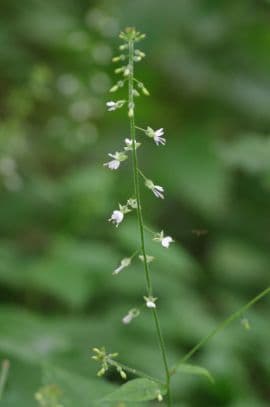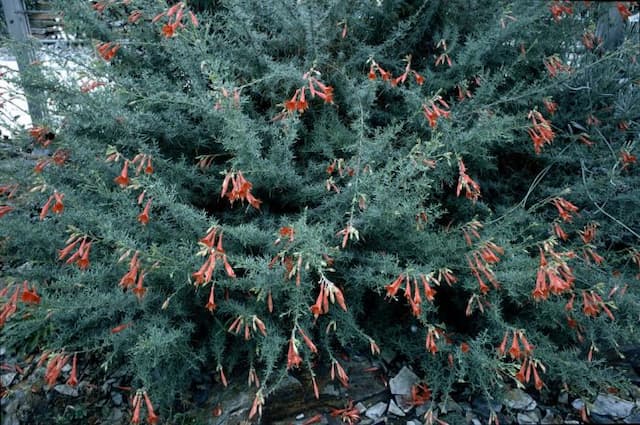Fuchsia Fuchsia Electric Lights = 'Nufu1' (PBR)
![fuchsia [Electric Lights]](/_next/image?url=https%3A%2F%2Fplants-admin.emdemapps.com%2Fimages%2Fplants%2F%2Fimages%2F604b5ba9b6455.png&w=3840&q=75)
ABOUT
The Fuchsia Electric Lights, known for its striking appearance, showcases a vibrant display of colors. This plant bears tube-shaped flowers that dangle beautifully from its branches, reminiscent of delicate, ornate earrings. These blooms typically exhibit an enchanting blend of deep purple to pink hues, sometimes presenting a gradation of color along their length, with lighter shades at the outer edges and a more intense pigmentation near the core. The petals at the end of the flowers flare outwards, creating a skirt-like effect which adds to the visual impact. The foliage of the Fuchsia Electric Lights complements its flowers, displaying lush green leaves that can have a slightly glossy finish. These leaves are usually oval-shaped, with a discernible veining pattern, which may give them a textured appearance. Together, the contrast between the vivid flowers and the verdant leaves makes the Fuchsia Electric Lights a highly ornamental plant, often sought after for its showy presentation and its penchant for attracting hummingbirds and other pollinators.
About this plant
 Names
NamesFamily
Onagraceae
Synonyms
Electric Lights Fuchsia
Common names
Fuchsia 'Nufu1' (PBR)
 Toxicity
ToxicityTo humans
Fuchsia Electric Lights is not known to be toxic to humans. Consequently, ingestion of this plant typically does not lead to any adverse symptoms or poisoning in humans.
To pets
Fuchsia Electric Lights is also not known to be toxic to pets. If pets ingest this plant, it is unlikely to cause them harm or result in poisoning symptoms.
 Characteristics
CharacteristicsLife cycle
Perennials
Foliage type
Deciduous
Color of leaves
Green
Flower color
Mixed
Height
2-3 feet (60-90 cm)
Spread
2-3 feet (60-90 cm)
Plant type
Shrub
Hardiness zones
9
Native area
Americas
Benefits
 General Benefits
General Benefits- Attractive Flowers: The Fuchsia 'Electric Lights' boasts vibrant, pendulous flowers that add a burst of color to any garden or container.
- Long Blooming: It has an extended blooming period, often lasting from early summer through fall, providing long-lasting visual interest.
- Habitat for Wildlife: The flowers attract hummingbirds and beneficial pollinators, offering a source of nectar and aiding in biodiversity.
- Low Maintenance: This plant is relatively easy to care for, requiring only regular watering and occasional pruning to keep it looking its best.
- Versatility in Landscaping: It can be used in a variety of garden settings, including borders, hanging baskets, and as a colorful accent in mixed containers.
- Tolerance to Partial Shade: Unlike many flowering plants, Fuchsia 'Electric Lights' can thrive in partially shaded environments, making it suitable for gardens with varied light conditions.
- Drought Resistance: Once established, it has moderate drought tolerance, reducing the need for frequent watering during dry periods.
 Medical Properties
Medical PropertiesThis plant is not used for medical purposes.
 Air-purifying Qualities
Air-purifying QualitiesThis plant is not specifically known for air purifying qualities.
 Other Uses
Other Uses- Fuchsia Electric Lights can be used as an inspiration for artists and photographers due to its unique and vibrant flowers, providing a compelling subject for creative projects.
- The plant can be utilized in educational settings, such as schools or botanical gardens, to teach about plant breeding and ornamental horticulture.
- Fuchsia Electric Lights’ bright flowers can be employed as natural dyes for fabrics or artisanal crafts, although testing for colorfastness is recommended.
- Its strong visual appeal can be used in marketing materials or product packaging where floral imagery is desirable for aesthetic enhancement.
- The plant can be incorporated into event decorations, such as weddings or parties, to create a colorful ambiance and thematic consistency.
- Fuchsia Electric Lights can contribute to ecological gardening by providing a food source for pollinators, such as bees and hummingbirds, in urban and suburban environments.
- When included in public and community gardens, this plant can be part of efforts to increase urban biodiversity and environmental awareness.
- In fashion, the plant may inspire textile patterns or color palettes for clothing and accessories due to its striking flower colors.
- As a living sculpture, professional gardeners or hobbyists can train Fuchsia Electric Lights into various shapes for garden art and topiary designs.
- The plant’s cascading growth habit could be used in set design and stage productions to create lush, natural backdrops or thematic elements within scenes.
Interesting Facts
 Feng Shui
Feng ShuiThe plant Fuschia is not used in Feng Shui practice.
 Zodiac Sign Compitability
Zodiac Sign CompitabilityThe plant Fuschia is not used in astrology practice.
 Plant Symbolism
Plant Symbolism- Elegance: The fuchsia 'Electric Lights' is known for its striking and elegant appearance, featuring delicate, lantern-shaped flowers that dangle gracefully from the plant.
- Maturity: The rich and vibrant hues of fuchsia flowers typically represent maturity and a fully blossomed state, which can symbolize the bearer reaching a state of readiness or enlightenment.
- Confiding love: Traditionally, fuchsia flowers have been associated with confiding love. Given as a gift, they express trust and a deep emotional connection.
- Good taste: Because of their unique beauty and intricate blooms, fuchsias are often associated with having good taste and sophistication in the aesthetic realm.
- Ambition: The vitality of the 'Electric Lights' variety, with its vivid colors, can symbolize ambition and the pursuit of personal goals with passion and vigor.
 Water
WaterFuchsia 'Electric Lights' prefers consistent moisture, so it's important to water when the top inch of soil feels dry to the touch, typically once or twice a week. Avoid letting the soil become completely dry. When watering, use room temperature water and apply it directly to the soil until it begins to run out of the drainage holes. For potted plants, this might equate to about one to two gallons every week, depending on the size of the pot and the environmental conditions. During hot or windy weather, you may need to increase the frequency of watering to maintain the moisture level.
 Light
LightFuchsia 'Electric Lights' thrives best in bright, indirect light with protection from the harsh afternoon sun. A north-facing or east-facing window is ideal for indoor plants, or a shaded spot outdoors where it can receive filtered sunlight. Too much direct sunlight can scorch the leaves, while too little light can cause poor growth and fewer flowers.
 Temperature
TemperatureThe ideal temperature range for Fuchsia 'Electric Lights' is between 55 and 75 degrees Fahrenheit. The plant can tolerate minimum nighttime temperatures down to around 40 degrees Fahrenheit, but should not be exposed to temperatures below this as it can become damaged by frost. It is not heat tolerant, so during periods of high temperatures, it is crucial to provide extra care to avoid heat stress.
 Pruning
PruningPruning Fuchsia 'Electric Lights' encourages bushier growth and more flowers. Trim back the tips of the branches in early spring to promote branching, and pinch off the flower tips after blooming to stimulate new flower production. Pruning is also necessary to remove dead or diseased wood, and should be done annually for the health of the plant. The best time for heavy pruning is late winter or early spring, before new growth begins.
 Cleaning
CleaningAs needed
 Soil
SoilFor Fuchsia 'Electric Lights', a well-draining soil with peat moss or a soilless potting mix is ideal. A pH between 6.0 and 7.0 suits this plant best, providing a slightly acidic to neutral environment for optimal growth.
 Repotting
RepottingFuchsia 'Electric Lights' should be repotted every two to three years or when it becomes root-bound. Refreshing the soil and upgrading the pot size encourages healthy growth.
 Humidity & Misting
Humidity & MistingFuchsia 'Electric Lights' thrives in moderate to high humidity levels, ideally between 60-70%. Avoid extreme humidity fluctuations for this plant's wellbeing.
 Suitable locations
Suitable locationsIndoor
Place Fuchsia 'Electric Lights' in bright, indirect light indoors and ensure high humidity.
Outdoor
Grow Fuchsia 'Electric Lights' in dappled shade outdoors and protect from harsh elements.
Hardiness zone
6-11 USDA
 Life cycle
Life cycleThe Fuchsia Electric Lights begins its life as a seed, from which it germinates in warm, moist soil conditions, usually in spring. During the seedling stage, it develops its first true leaves and establishes a root system. As it enters the vegetative stage, the plant focuses on leaf and stem growth, preparing for budding. Flowering occurs typically in the warmer months, with the distinctive pink and purple blooms characteristic of the fuchsia attracting pollinators for reproduction. After pollination, the flowers develop into small fruit with seeds, which when mature, drop to the ground or are dispersed to begin a new cycle. The plant can go dormant in colder months, particularly in regions with frost, but with proper care, it can survive and re-emerge during the next growing season.
 Propogation
PropogationPropogation time
Spring-Early Summer
The Fuchsia Electric Lights 'Nufu1' is most commonly propagated through softwood cuttings. This method is typically undertaken in late spring to early summer when new growth is soft and pliable. To propagate by cuttings, a 2 to 4-inch (5 to 10 centimeters) segment of a non-flowering shoot is snipped just below a leaf node. The lower leaves are removed, and the cut end may be dipped in rooting hormone to encourage root development. The cutting is then placed in a well-draining potting medium and kept in a humid environment with indirect light until roots have established, which generally takes a few weeks. Regular misting helps maintain humidity levels. Once rooted, the plant can be transplanted into a larger pot or garden setting.









